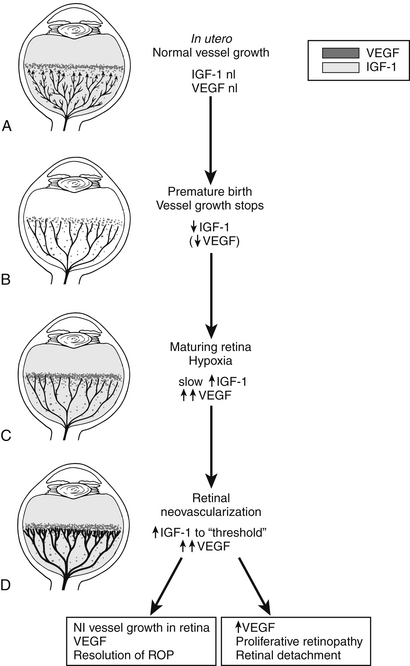Neonatal Ophthalmology
Normal Visual Development
The pupillary light reflex should be observable after 31 weeks’ gestational age. A blink reflex to light can often be observed a few days after birth. 123
Basic Ocular Examination
Strabismus refers to misalignment of the eyes. Intermittent strabismus is often observed in the newborn and tends to resolve. Strabismus that persists beyond the first few months of life should be referred to an ophthalmologist for further evaluation. 45
ROP
Retinal vascular development begins during the second trimester of pregnancy, and full maturation typically occurs during or after the third trimester of pregnancy. In premature babies much of this development is taking place ex utero. The abnormal retinal development seen in ROP is in response to the artificial environment experienced by the neonate after birth.
In the first phase of pathogenesis, hyperoxia leads to cessation of the normal vascular development of the peripheral retina. In the second phase increased metabolic demand causes relative hypoxia to the peripheral retina, which leads to increased production of pro-angiogenic growth factors such as vascular endothelial growth factor (VEGF) in the eye. This in turn stimulates abnormal proliferative vascular development. The proliferation can cause traction on the retina and bleeding inside the eye, which leads to vision loss ( Fig.15-1).

Figure 15-1 Schematic representation of IGF-1/VEGF control of blood vessel development in ROP. A, In utero, VEGF is found at the growing front of vessels. IGF-1 is sufficient to allow vessel growth. B, With premature birth, IGF-1 is not maintained at in utero levels, and vascular growth ceases despite the presence of VEGF at the growing front of vessels. Both endothelial cell survival (AKT) and proliferation (MAPK) pathways are compromised. With low IGF-1 and cessation of vessel growth, a demarcation line forms at the vascular front. High oxygen exposure (as occurs in animal models and in some premature infants) may also suppress VEGF, further contributing to inhibition of vessel growth. C, As the premature infant matures, the developing but nonvascularized retina becomes hypoxic. VEGF increases in retina and vitreous. With maturation, the IGF-1 level slowly increases. D, When the IGF-1 level reaches a threshold at 34 weeks’ gestation, with high VEGF levels in the vitreous, endothelial cell survival and proliferation driven by VEGF may proceed. Neovascularization ensues at the demarcation line, growing into the vitreous. If VEGF vitreal levels fall, normal retinal vessel growth can proceed. With normal vascular growth and blood flow, oxygen suppresses VEGF expression, so it will no longer be overproduced. If hypoxia (and elevated levels of VEGF) persists, further neovascularization and fibrosis leading to retinal detachment can occur. (Smith LEH. Pathogenesis of retinopathy of prematurity. Semin Neonatol 2003;8:469–73.)


